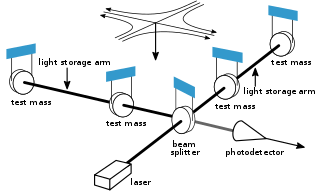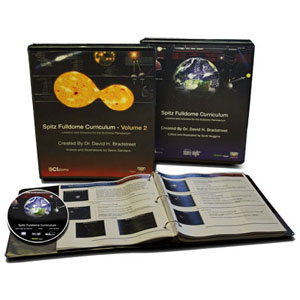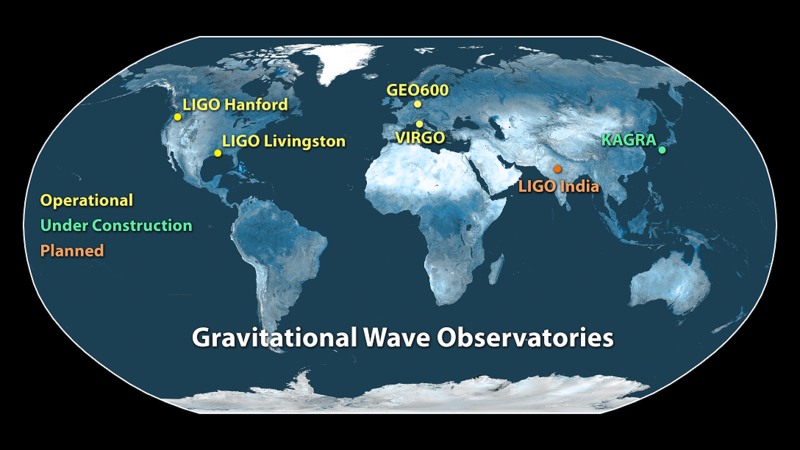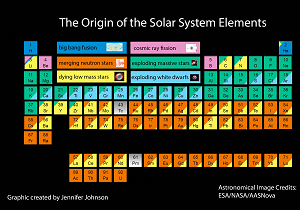On August 17th, the Laser Interferometer Gravitational-Wave Observatory, or “LIGO”, detected gravity waves produced by the merger of two neutron stars. There are lots of good takes on this story, and it’s important that we keep retelling it in interesting ways. This entry briefly summarizes the observations of the event, while focusing in on a couple of ways that a SciDome planetarium show about this could be exciting for an educational audience.

A neutron star is the typical remnant left behind after a supernova explosion. Specifically, this is the kind of supernova that overtakes a massive star at the end of its lifespan, when heavy elements have accumulated at its core. Massive stars that go supernova tend to have short lifespans on the cosmic scale, only a few million years.
In a supernova, the outer layers of the star collapse onto the core, compress it, and rebound outwards in an explosion. The core is left behind, but the pressure of the infalling layers squeeze it to the point that normal matter made up of atoms can no longer exist. It is squeezed so tight that orbiting electrons and core protons violate the Pauli Exclusion Principle and combine into neutrons that have no net charge.
A neutron star is a small but extremely massive object made up of this “neutron-degenerate matter” that has no protons or electrons, with no space in between the nuclei. “Neutronium” is extremely dense, so that a teaspoon full of it would weigh two billion tonnes. The diameter of the neutron star is only a few miles.
The type of supernova that can create a neutron star tends to occur in a given galaxy roughly once per century. Neutron stars that rotate can be observed in radio waves as “pulsars”. Due to the law conservation of angular momentum on a rapidly collapsing massive object, pulsars tend to rotate extremely quickly.

You can review the lesson plan for the Fulldome Curriculum minilesson in your SciDome named “Galactocentric Distributions”, which has a step that highlights the locations of supernova remnants like pulsars. That ATM-4 lesson uses the Starry Night database “Supernova Remnants” which can also be toggled on and off manually.
Although neutron stars are rare (one such may be created in a galaxy of 100 billion stars after an interval of 100 years), it is possible for two pulsars to be observed orbiting each other. Since they were first observed in 1967, hundreds of pulsars have been observed in the Milky Way, and there is also a suspected population of neutron stars that can’t be observed. So far there are two known binary pulsars in the Milky Way.
Until LIGO was completed in 2002 and then upgraded in 2015, the only method of observing the effects of gravitational waves was to use a radio telescope to time the regular pulses of a binary pulsar and measure its rate of slowing. Einstein’s general theory of relativity describes gravity as a warping of space/time around massive objects. As a pair of pulsars orbit each other, some of their rotational energy is carried away by the propagation of gravitational waves. The first known binary pulsar has an orbital period of about 7 hours, and the timing of its pulses has revealed a small orbital contraction. That pair may take 300 million years to spin together.
Since LIGO was upgraded in 2015, it has started to discover gravitational wave events caused by black holes merging. Mergers of stellar-mass black holes are somewhat common in the deep cores of galaxies and maybe some other places in the universe, but so far no black hole mergers have been observed by LIGO with enough accuracy to find their host galaxies.

The two stations of LIGO are located in eastern Washington state and in rural Louisiana. The sensitivity of the system has recently been improved through collaboration with the European gravitational wave observatory Virgo, located outside Pisa, Italy. These locations can be visited in SciDome with The Layered Earth.
The August 17th event that’s now in the news (GW170817) was the collision of a pair of neutron stars in another galaxy. It is notable because it’s the first observed neutron star collision, and because its optical component was found thanks to triangulation between gravitational wave observatories and gamma-ray observatories.
The Swift Gamma-Ray Burst spacecraft is one of the stars of the fulldome show Black Holes: The Other Side of Infinity. Networking of several observatories is also a feature of We Are Astronomers and other planetarium shows.
One aspect of the breaking nature of the story is that although the news was embargoed from distribution until this week, rumors have been circulating about it since the day it happened, a few days before the total solar eclipse in August. Now that the papers have been published, notably B.P. Abbott et al. in Physical Review Letters, the scale of the collaboration becomes apparent. There are so many co-authors on these papers that it has been guesstimated that 15% of all professional astronomers are being cited. No wonder it was difficult for them to keep a secret!
The rapid outburst and the quick dimming of the object was less impressive than a supernova – maybe only a tenth as bright as a supernova, so the name “kilonova” has been proposed to distinguish this kind of an event from a supernova.
The host galaxy is also very close to us. One of my other hats apart from Spitz is as a supernova hunter. I’ve co-discovered ten supernovae by searching through images of external galaxies, and although it is not atypical for one or even two supernovae per year to turn up in galaxies that are less than ten million light years away, I have never found one that was closer than 215 million light years. The host galaxy, NGC 4993, is only about 120 million light years away.
NGC 4993 is so close that it was observed visually in the late 18th Century, before photography was invented, with an 18-inch reflecting telescope with a speculum metal mirror. The greatest father-and-son team of astronomers in history – William and John Herschel – found it 45 years apart.
Did I mention that neutron star collisions are rare? A given galaxy may only host a binary neutron star collision once per 100,000 years, and there are only on the order of 100,000 galaxies in the volume with radius 120 million light years.
You can look up NGC 4993 in Starry Night and dial up the location and the date of its discovery: Slough, England on March 26th, 1789. This galaxy isn’t easy to see from so far north. It only gets 16° above the southern horizon as seen from Slough.
You can also dial up the discovery date of the gravitational wave event – August 17th of this year. One of the points that’s been made is that in August, NGC 4993 sets a couple of hours after the Sun, and is not easy to find in the short time available after sunset. By the time of this week’s announcement, NGC 4993 has gone behind the Sun and no new observations can be made by anybody until it returns in the predawn sky. If the gravitational waves event had happened two months later, the source of GW170817 would not have been found.
You can also fly out to the host galaxy to observe it in three dimensions with Starry Night. The name NGC 4993 is not “flyable”, so we have to type in the name that is attached to this galaxy in one of the newer catalogs that renders it as a 3D object. In the search field, type in:
2MASS-13094770-2323017
The phrase “We are star stuff” has been a part of the astronomer’s public outreach lexicon for many years, since Carl Sagan. We know how to point out that all the heavy elements that make up solid matter on Earth were fused out of lighter elements in the cores of stars, and that iron and everything heavier than it was produced by supernova explosions. It’s now time to re-invent the part of this expression that deals with a lot of those heavy elements.
The neutron star collision in NGC 4993 seems to have produced more than 10 Earth masses of gold, platinum and other precious metals. Dr. Jennifer Johnson from The Ohio State University, a SciDome user, posted a Periodic Table of the Elements on her blog that has been broken down to highlight which elements can be generated by supernovae, colliding neutron stars, etc.
